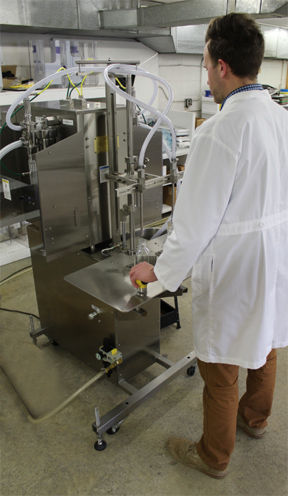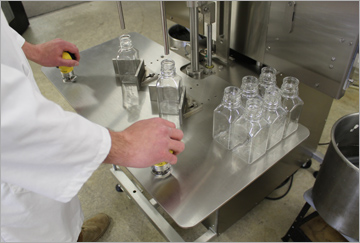In most manufacturing environments when a customer’s project is completed, there is a formal review performed with both parties in attendance. Depending on the complexities of the application, or the overall solution provided, this review can last a matter of hours to several days. When a FILAMATIC liquid filling machine has completed the manufacturing process, there are several important steps FILAMATIC takes prior to shipping the machine to the customer. This final process is commonly known as a Factory Acceptance Test (FAT).
Today we have an interview with our in-house Factory Acceptance Testing (FAT) expert, Mark Evans. Mark is FILAMATIC’s Service and Assembly Department Manager and has been in the liquid filling business for a long time. He has overseen numerous Factory Acceptance Tests over the years. His knowledge of liquid filing machines and the FAT process in our industry is unmatched.
Mark shares what to expect during Factory Acceptance Tests, his thoughts on forgoing FATs, the best way to communicate with the liquid filling equipment manufacturer and more.
Factory Acceptance Testing
 FILAMATIC – How do you explain the factory acceptance testing (FAT) process to customers? Especially ones that have never done it before.
FILAMATIC – How do you explain the factory acceptance testing (FAT) process to customers? Especially ones that have never done it before.
Mark Evans – Normally when they show up for an FAT, we sit down in our conference room, go over protocol.
What we do is, go over machine components, explain purpose, how they function. We also go over maintenance of equipment with the customer. We explain the operation with them and any changeovers. We do this part on the floor at the machine.
We then go into the shop and do simulated production runs and verify the machine’s operation is meeting customer’s expectations.
FILAMATIC – What should a customer know going into factory testing?
MarkE – The more information you provide to us, the better. That is a big thing. Going into the FAT with all the info we need. This information could be fill speeds, accuracy, torque specs, and possibly more.
If we have a checklist before you come in, we can review it sooner for a smooth FAT process.
We always like to have a phone call before the customer comes in. When they get here we have an agreed upon document and procedure.
The more information collected and shared, the better everyone can be prepared [for the FAT]. We want to go into this with both sides prepared and a success for all involved. Not go into this and you not be happy.
It is also best to start the FAT on-time. We never know what will come up during these factory tests, so it is best to utilize the allotted timeframe in the best way possible.
FILAMATIC – What is the typical length of an FAT?
ME – It varies on the type of machine. For instance our ProLINE’s are typically 1 day – 3 days and our Monoblocs can be 2 -5 days.
It can also depends on the application and industry. Pharmaceutical FATs are sometimes at least a week due to all the data.
FILAMATIC – If something goes wrong during a factory acceptance test, how do you deal with it?
MarkE – Depends on what it is. If we can address it, we do it right away.
If it is a minor thing and we can change that. There are people that can address it immediately.
Other times we address it at the end. We have a customer make a list as they go.
If it is something, like maybe they want to change a key or text on the screen, that is a process to change.
FILAMATIC – If a customer isn’t happy with a machine or needs certain changes or details taken care of, what is the best way to communicate these needs?
MarkE – Stay on top of things as we go through the FAT. Put it on the list, “Go ahead and put it on the list.” is what we encourage customers to do.
We keep an open dialogue and are working right there with you. As things develop we all want to be aware of what is going on.
FILAMATIC – What concerns or issues are there when doing a FAT off-site at a client’s business?
MarkE – You are actually in a production environment and you will see things you didn’t see here.
We can only do shorter production runs. When we go into the field, customers have tanks and product, so they can feed into the filling machines steady.
A customer is going to run a lot more product, so you might see something. These are full tanks and everything, and they are going into full production mode.
The customer could be running with overhead pressure. At our assembly facility we might have been from the ground. The bottles that were sent to us, could be vary in size and shape at the customer’s facility.
Operators can change things as well. Often an untrained operator might push buttons aimlessly.
There are things in the field you couldn’t test or anticipate factory testing here.
FILAMATIC – Is it good to do Factory Acceptance Testing and setup at our facility, the customer’s facility, or both?
 MarkE – Doing both is good. It is ideal to have refresher course working with the customer at their facility.
MarkE – Doing both is good. It is ideal to have refresher course working with the customer at their facility.
First time customers and those purchasing a machine with full automation, Monoblocs. There is a lot of benefit to have one of our technicians come out with the machine to handle setup.
FILAMATIC – Some customer’s want to forgo doing Factory Acceptance Testing and just want machines sent to them. In your experience is this ever a good idea?
MarkE – No.
The only time this works is if the customer is getting a duplicate machine. Essentially a machine they have already ordered from us and been running for a period of time. They just need additional liquid filling equipment to increase capacity. In this scenario they have already done a FAT on a similar model of that machine.
From our experience when the machine gets to a client, and the customer has forgone a FAT, they get a great piece of liquid filling machinery. However, they will not know how to run it.
We will get a phone call the machine is not filling and capping right. In this situation it is just setup issues, they often didn’t read the manual.
They struggle with the operation of the machine. How to prime the pumps, how to set the clutches, getting the machine up to temperature, etc.
Doing a FAT here on site with us would solve these issues upfront. FATs are worth the investment and time for all parties involved.
FILAMATIC – What happens immediately after the FAT is finished?
MarkE – We sit down and will do a sign-off, who was there and present for the FAT. We cover pass through rate, accuracy, and all those important details. We will also discuss maintenance of the filling machine.
What happens next is we ask them about shipping. Do they want to us to handle and schedule shipping or do they want to get quote from us via our partners. Do they want service installation as well? We get this all squared away or sometimes the customer will let us know.
If there are concerns the customer has about the machine, we will refer back to the list. We assign those to engineering or our department. If an additional feature needs to be added, that will go back to sales so the customer can receive a quote.
Once shipping details are taken care of, the customer’s machine will not ship until they send the last payment is sent. That is between our Customer Service department and isn’t something that is taken care of in Assembly.
FILAMATIC – Given the advent of today’s technology, are you seeing more video and pictures being used for technical service?
MarkE – Me, a little bit… but BillS, Senior Technical Service Rep, does see the incorporation of more contemporary technology into the FAT process as far as visual communication quite a bit. It’s often easier for him to request, “Can you capture a picture or video of the issue?” Then he can see and knows what’s exactly going wrong and how best to advise and help the customer.
In closing, we hope this interview gave you a better understanding of the Factory Acceptance Testing process. We always welcome any questions, comments or concerns from customers regarding FAT processes and procedures.
In the future we hope you will one day visit our facility for a factory acceptance test.
